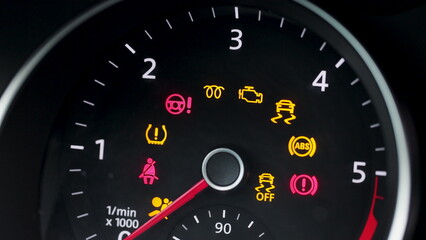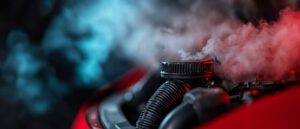
Top Reasons Your Check Engine Light Might Be On

The check engine light (CEL) is one of the most dreaded warnings for car owners. When that little amber light illuminates on your dashboard, it’s easy to feel anxious or frustrated. While the check engine light can signal a serious problem, it can also indicate minor issues that are easy to resolve. Understanding the common reasons behind the CEL can help you act quickly, maintain your car’s performance, and avoid costly repairs.
Here’s an in-depth look at the top reasons your check engine light might be on and what you should do about it.
1. Loose or Faulty Gas Cap
Believe it or not, a loose or damaged gas cap is one of the most common causes of a check engine light.
- Why It Happens: The gas cap creates a seal for the fuel system, preventing fuel vapors from escaping. A loose or broken cap disrupts the pressure in the system, triggering the CEL.
- How to Fix It: Check if your gas cap is loose and tighten it until it clicks. If the light doesn’t go off after a few drives, inspect the cap for cracks or wear. Replacing it with a new one is inexpensive and easy.
2. Faulty Oxygen Sensor
The oxygen sensor (O2 sensor) monitors the amount of unburned oxygen in your car’s exhaust system and helps optimize fuel efficiency and emissions.
- Why It Happens: Over time, the sensor can become dirty or fail entirely, leading to incorrect readings. This can result in poor fuel economy, increased emissions, and engine performance issues.
- How to Fix It: A mechanic can test and replace the oxygen sensor if necessary. Replacing a faulty sensor promptly can save you money on fuel and prevent further engine damage.
3. Catalytic Converter Problems
The catalytic converter is a vital component of your car’s exhaust system, responsible for converting harmful gases into less harmful emissions.
- Why It Happens: A malfunctioning catalytic converter can result from engine misfires, oil leaks, or a failure to address other CEL-related issues. Symptoms include reduced fuel efficiency and sluggish performance.
- How to Fix It: Replacing a catalytic converter is expensive, so it’s crucial to address underlying problems early to prevent further damage. Regular maintenance can extend the life of this component.
4. Mass Airflow Sensor Issues
The mass airflow (MAF) sensor measures the amount of air entering the engine, helping the computer determine the correct fuel-to-air ratio for combustion.
- Why It Happens: The sensor can get dirty or fail over time, often due to neglecting air filter changes. A faulty MAF sensor can lead to rough idling, stalling, or decreased fuel efficiency.
- How to Fix It: Replace the air filter regularly to prevent sensor problems. If the sensor is faulty, have a mechanic replace it.
5. Worn or Faulty Spark Plugs and Ignition Coils
Spark plugs and ignition coils work together to ignite the air-fuel mixture in your engine’s cylinders.
- Why It Happens: Worn spark plugs or failing ignition coils can cause misfires, rough idling, and reduced engine performance, triggering the CEL.
- How to Fix It: Replace spark plugs according to your vehicle’s maintenance schedule. Ignition coils may also need replacement if they show signs of wear or failure.
6. Faulty Exhaust Gas Recirculation (EGR) Valve
The EGR valve reduces emissions by recirculating a portion of your engine’s exhaust back into the cylinders.
- Why It Happens: Over time, the EGR valve can become clogged with carbon deposits, leading to engine knocking, rough idling, or decreased fuel efficiency.
- How to Fix It: Cleaning the valve can sometimes resolve the issue, but a replacement may be necessary in severe cases.
7. Malfunctioning Thermostat
The thermostat regulates your engine’s operating temperature, ensuring it doesn’t overheat or run too cold.
- Why It Happens: A malfunctioning thermostat can cause erratic engine temperatures, reduced fuel efficiency, and increased emissions, triggering the CEL.
- How to Fix It: Replace the thermostat if it’s stuck open or closed to restore proper temperature regulation.
8. Vacuum Leaks
Your car’s vacuum system performs various functions, from supporting the brake booster to managing emissions.
- Why It Happens: Cracked hoses, a faulty vacuum pump, or a damaged intake manifold can cause vacuum leaks, leading to a rough idle, poor acceleration, and the CEL.
- How to Fix It: Have a mechanic inspect the vacuum system to identify and repair leaks. Replacing damaged hoses is a common solution.
9. Transmission Problems
In some vehicles, transmission issues can trigger the check engine light.
- Why It Happens: Faulty sensors, low transmission fluid, or mechanical problems can affect performance and trigger a warning light.
- How to Fix It: Addressing transmission problems promptly is crucial to avoid further damage. Regular fluid changes and inspections can prevent many issues.
10. Aftermarket Accessories
Aftermarket accessories like remote starters, alarms, or performance tuners can interfere with your car’s electronics.

- Why It Happens: Poorly installed or incompatible accessories can disrupt the vehicle’s communication systems, causing the CEL to turn on.
- How to Fix It: Have a professional inspect and correct any wiring or compatibility issues.
What to Do When the Check Engine Light Comes On
When your check engine light illuminates, don’t panic. Follow these steps to determine the next course of action:
- Check the Gas Cap: Start with the simplest solution. Ensure the gas cap is tight and inspect it for damage.
- Observe the Light’s Behavior: A steady light indicates a non-urgent issue, while a flashing light often signals a severe problem that requires immediate attention.
- Listen for Symptoms: Pay attention to how your car is running. Are there unusual noises, reduced power, or poor performance?
- Use a Code Reader: An OBD-II scanner can read diagnostic trouble codes (DTCs) to help identify the issue. Many auto parts stores offer free code reading services.
- Consult a Mechanic: If you’re unsure of the problem or the light persists after addressing minor issues, visit a trusted mechanic for a thorough diagnosis.
Preventing the Check Engine Light
Regular maintenance is the best way to minimize the chances of seeing the CEL. Here’s how you can keep your car in top shape:
- Follow the Maintenance Schedule: Stick to your manufacturer’s recommended maintenance intervals for oil changes, spark plug replacements, and more.
- Use Quality Parts: Use OEM (original equipment manufacturer) parts for replacements to ensure compatibility and reliability.
- Address Issues Promptly: Don’t ignore minor problems, as they can escalate into major repairs over time.
- Monitor Fluids and Filters: Check and replace fluids and filters regularly to maintain optimal performance.
Conclusion
The check engine light can be alarming, but it’s often a sign of a manageable issue. By understanding the common reasons behind the CEL and addressing them promptly, you can keep your car running smoothly and avoid costly repairs.
Remember, preventive maintenance and regular inspections are the keys to minimizing unexpected problems. If your CEL comes on, take action to ensure your car remains safe, efficient, and reliable on the road.
Share :

LeClaire Auto Repair provides trusted auto repair services to keep your car running smoothly. With expert care and helpful advice, we’re here for all your maintenance needs. Follow us for tips and updates!

LeClaire Auto Repair provides trusted auto repair services to keep your car running smoothly. With expert care and helpful advice, we’re here for all your maintenance needs. Follow us for tips and updates!
Latest Post


Top 5 Maintenance Tips to Extend Your Car’s Lifespan

Winter Car Care: Protecting Your Vehicle in Cold Weather

